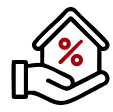Bank Statement Loan Examples & Use Cases
If you’re self-employed and struggling to qualify for a traditional mortgage, you’ve probably heard about bank statement loans. These alternative financing options help entrepreneurs, freelancers, and business owners who can’t easily document their income through W-2s or traditional pay stubs qualify for a mortgage loan. So, how do bank statement loans work? Let’s explore real-world bank statement loan examples and scenarios to help you understand if this financing option makes sense for your situation.



 Outstanding Client Experience
Outstanding Client Experience Specialized Lending Solutions
Specialized Lending Solutions Direct-to-Consumer Advantage
Direct-to-Consumer Advantage We're Advisors, NOT Salespeople
We're Advisors, NOT Salespeople Effortless Digital Mortgage Platform
Effortless Digital Mortgage Platform
Who Are Bank Statement Loans for?
A bank statement loan is designed for self-employed borrowers who have difficulty providing their income through traditional documentation. These non-QM loans offer flexibility that conventional mortgages simply can’t match.
Here’s who typically benefits from bank statement loans:
- Business owners: Those who own their own companies and take significant tax deductions that reduce their reported income on tax returns.
- Independent contractors: Professionals who work for themselves and receive 1099s rather than W-2s from multiple clients or companies.
- Freelancers and consultants: Creative professionals, writers, designers, and consultants who have irregular income patterns but strong earning potential.
- Real estate agents: Agents whose commission-based income can vary from month to month.
- Construction contractors: Builders, electricians, plumbers, and other trades professionals who run their own businesses.
- Restaurant owners: Food service entrepreneurs whose cash-heavy businesses may not reflect true income on tax documents.
- Medical professionals: Doctors, dentists, therapists, and other healthcare providers who own their practices and take business deductions.
The key requirement is being self-employed for at least two years, though some lenders may consider shorter business histories with strong financial profiles.
Bank Statement Loan Use Cases
Let’s dive into specific bank statement loan use case scenarios. These examples will help you understand how bank statement mortgages work in practice.
-
1. “I’m self-employed and looking to buy a home but take advantage of a lot of write-offs in order to minimize my tax burden. This means my tax returns aren’t a great way to show my income. Would a bank statement loan be appropriate in this case?”
Absolutely. This is the perfect bank statement loan scenario. When you’re self-employed and taking legitimate business deductions to reduce your tax liability, your tax returns often don’t reflect your actual cash flow or ability to make mortgage payments.
Let’s look at a bank statement loan example: Instead of looking at your adjusted gross income from tax returns, the lender will review 12-24 months of your business or personal bank statements. They calculate your average monthly deposits and use that figure to determine your qualifying income.
For instance, if your tax return shows $60,000 in income after deductions, but your bank statements show consistent monthly deposits of $12,000 ($144,000 annually), the bank statement loan would qualify you based on the higher amount.
-
2. “I’m self-employed and interested in buying a home. However, I don’t qualify for a conventional mortgage due to tax write-offs. In this case, would a bank statement loan or asset-based loan be better?”
The answer depends on your specific situation and the consistency of your income. Choose a bank statement loan if you have regular, consistent deposits in your business accounts and have been self-employed for at least two years.
At the same time, you might also consider an asset-based loan if your income is highly irregular, you haven’t been in business very long, or you have significant liquid assets but inconsistent cash flow.
Most self-employed borrowers find bank statement loans more favorable because they’re based on actual business performance rather than just asset value. A bank statement loan calculator can help you estimate your qualifying income based on your deposits.
-
3. “I’ve been running the family business for years and am looking to buy a home. The business has been around for 20 years and I’ve been acting owner for the last 10 years, but I only became the official owner last year once my father officially retired. Could I still qualify for a bank statement loan?”
Yes, you can still qualify, but you’ll need to document your role carefully. Lenders understand that family business transitions don’t always happen on paper immediately.
You’ll need documentation showing your operational control over the past two years, such as signing authority on business accounts, contracts in your name, or business licenses listing you as the operator. Bank statements should show consistent deposits under your management, not just since the official ownership transfer.
This bank statement mortgage example shows why lenders look at substance over form — they care more about who’s actually running the business and generating income than just official paperwork dates.
-
4. “I’ve been a real estate agent for the past 12 years but in the last few years began flipping houses on the side. If I apply for a bank statement loan, will the lender only count my commission income? Or will the cash deposits made from flipping houses be taken into account as well?”
Lenders will consider both income sources, which is great news for your qualifying power. Your commission income from real estate sales will be straightforward to verify through your business bank statements.
For house flipping income, lenders will examine the deposits from property sales but may apply different calculations. Since flipping income can be irregular and project-based, they might average it over a longer period or apply a lower percentage to account for the cyclical nature.
To strengthen your application, keep detailed records of your flipping projects, including purchase contracts, renovation receipts, and sale proceeds.
-
5. “The pre-approval amount for my bank statement loan was lower than I expected. How is monthly income calculated with bank statement loans? And how could I potentially increase my pre-approval amount?”
Bank statement loan income calculation typically works by averaging your monthly deposits over 12-24 months. The percentage of deposits that are counted as income depend on whether funds are deposited into a personal or business account. 100% of personal deposits are counted towards income for a bank statement loan, while typically 50% of business deposits are counted.
Here’s how this works: If your average monthly deposits are $10,000, the lender might use 50% of that ($5,000) as your qualifying income.
To increase your pre-approval amount, you can:
- Provide additional months of statements showing higher deposits
- Document business expenses separately if they’re lower than the lender’s assumed percentage. For example, if you have a business with only 25% in expenses and can provide a CPA letter verifying such you’ll be able to qualify for a higher mortgage loan amount.
- Include all business accounts
- Consider a self-employed mortgage with additional documentation, like profit and loss statements

-
6. “I’m self-employed and my spouse has a W-2 job. We want to maximize the loan amount we qualify for, but the write-offs I take significantly reduce eligible income for a conventional loan. If we use a bank statement loan, would it take my spouse’s W-2 income into consideration?”
Yes, this is often the ideal scenario for maximizing your loan amount. Most lenders will combine your bank statement income with your spouse’s W-2 income to calculate your total household qualifying income.
Your spouse’s W-2 income gets calculated using standard debt-to-income ratios, while your self-employed income gets calculated using the bank statement method. The lender then adds both income sources together for your total qualifying income.
This hybrid approach often results in better loan terms since W-2 income is considered more stable by lenders.
-
7. “I own half of a company, with the other half owned by a business partner. Can I still qualify for a bank statement loan?”
Yes, you can still qualify, but you’ll need additional documentation to verify your ownership percentage and income allocation. You’ll need partnership agreements that clearly show your 50% ownership stake. The lender will calculate your qualifying income based on your percentage of the business deposits.
Bank statements should ideally show separate draws or distributions to each partner. If the business mixes all income in shared accounts, you might need your accountant to provide a letter explaining how income is allocated between partners.
Have More Questions About Bank Statement Loans?
Bank statement loans offer incredible flexibility for self-employed borrowers who don’t fit into the conventional mortgage box. Whether you want to purchase a home, need a self-employed refinance, or are exploring a self-employed home equity loan, these programs can help you achieve your homeownership goals.
At Griffin Funding, we specialize in helping entrepreneurs and business owners navigate the mortgage process. Ready to explore your options? Reach out to connect with our team and explore your options, download the Griffin Gold app to compare loan options, or get started online today.
Find the best loan for you. Reach out today!
Get StartedFrequently Asked Questions
How does a bank statement loan work? 
What are current bank statement loan rates? 
Check out our mortgage rates page for today’s bank statement loan rates.
What credit score is needed for a bank statement loan? 
What's the minimum down payment for a bank statement loan? 
- Borrowers with credit scores of 680+ can put down as little as 10%.
- Borrowers with 680+ credit scores need at least 15% down.
- Borrowers with 620+ credit score need to put at least 20% down.
Recent Posts
Net Operating Income: Definition, Formula, & Examples
What Is Net Operating Income (NOI)? Net operating income measures how much money your investment property gene...
Best DSCR Lenders: Griffin Funding vs Angel Oak vs Kiavi vs Visio vs Lima One vs Easy Street
What to Look for in a DSCR Lender Choosing the best DSCR lender for your unique situation means evaluating sev...
Cash on Cash Return in Real Estate: Definition, Formula, & Examples
What Is Cash on Cash Return? Cash on cash return (CoC) is a metric that measures the annual income you generat...









